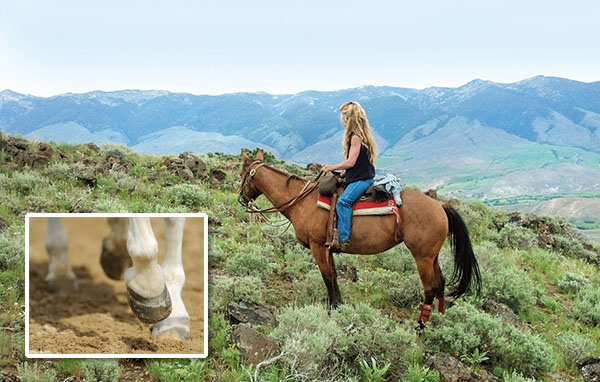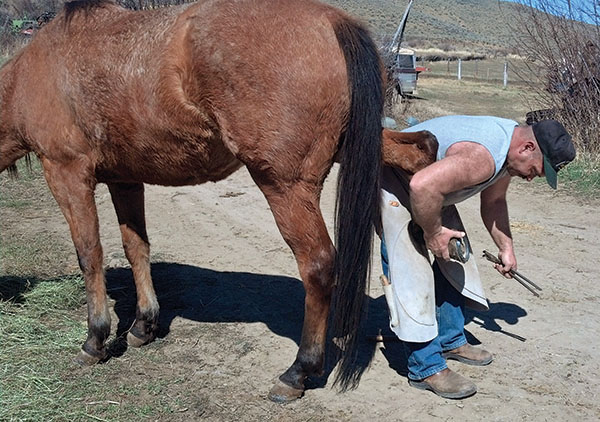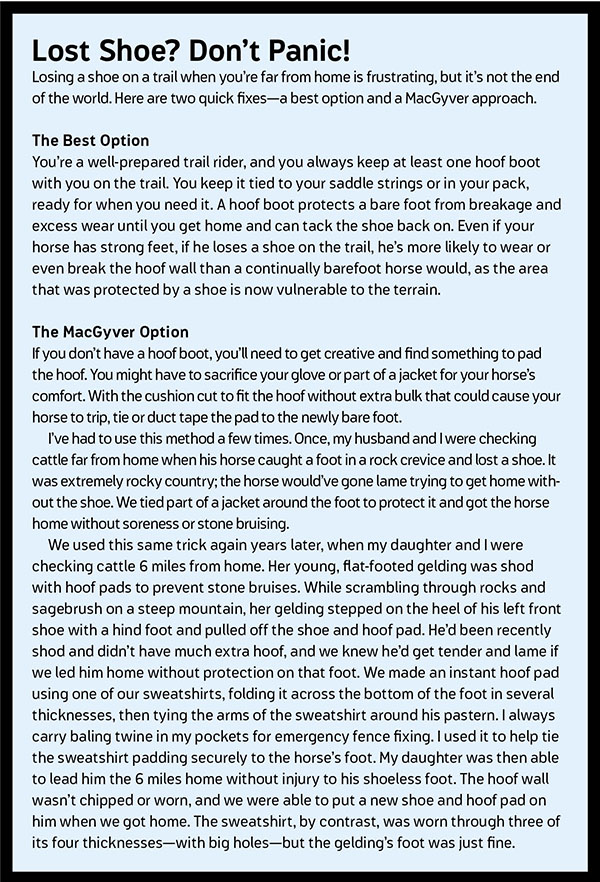Your horse’s hooves are literally the foundation of his entire life, so you know they require proper care and diligent attention. But if you’re a trail rider—whether you take the occasional excursion or spend the majority of your time out in nature—your horse’s feet require extra TLC.

I fall into the “avid trail rider” category, both for recreation and to manage my ranch. Here I’ll share some basic hoof knowledge as it pertains to the trail horse, plus offer tips for caring for your horse’s shod or barefoot hooves. In the boxed item, I’ll tell you what to do when your horse loses a shoe on the trail. I say “when” rather than “if” because if your horse wears shoes, it is going to happen, so you need to be prepared.
Hoof Basics
Exercising sound hoof-care practices requires a basic understanding of the hoof and how it works. Each horse is an individual and has his own quirks, and that’s true of his feet, too. Some horses have strong, hard feet that rarely have problems, while others have softer or more brittle hooves that need more frequent attention and care to keep them from chipping, splitting, or wearing away too fast. Here are a few nuggets of hoof knowledge that’ll help you make the best choices for your horse’s feet.
Hoofs are stronger if kept dry. Hoof horn is like your fingernails—the insensitive outer covering protects the inner, sensitive living tissues. Keeping the hoof wall and sole healthy and strong prevents problems like hoof cracks, abscesses, thrush, and white line disease. Keep the feet dry to maintain the hoof wall’s strength. As is true for your fingernails, constant moisture can weaken the hoof horn. It becomes softer, making it harder for the hoof to hold a shoe. It also becomes more damage-prone, or likely to wear away too quickly if the horse is barefoot. Continuous wet-dry cycles are hard on feet as well—just as being in and out of water is hard on your hands and can lead to cracking.
More natural living situations (pasture) offer hoof benefits. Wild horses have strong feet and healthy hoof horn because they travel over dry ground and their feet wear down about the same speed as they grow. Horses kept in confinement such as a stall or pen—where feet may be in contact with manure and urine (which damage hoof horn)—need more hoof care. Check your horse’s feet and clean them daily to remove any bruise-causing rocks and wet mud that can lead to thrush (bacterial growth). Schedule regular trimming/shoeing to help keep feet healthy and prevent lower-leg lameness.
Diet is key for healthy hoofs. A balanced diet containing all the important nutrients for healthy hoof horn is essential. Good pasture provides these nutrients. If your horse doesn’t have access to pasture, ask your veterinarian or equine nutritionist about feeding a hoof supplement, depending on the quality of your hay/grain and your horse’s hoof strength.
The Shod Trail Traveler
If you choose to put shoes on your trail horse, shoe him for the job and the conditions he travels over, ensuring that the shoes adequately protect his feet and stay on. Your farrier should pay close attention to the hooves’ balance so they land flat, break over the center of the toe, and travel straight (to the best of your horse’s conformation and natural leg action) so he’ll never hit himself.

Shoeing for trail riding is different from shoeing a show horse. Your horse needs well-fitting, tight shoes with strong clinches.
Adequate protection and traction are also important. If your horse has relatively flat feet and travels through rocky terrain, ask your farrier about toe and heel calks or hoof pads to protect from bruising. For rocky or slippery terrain, keep traction in mind. Shoes with raised toes and heels are often adequate, but in some instances your farrier might weld a dab of borium (tungsten carbide) to the toe and heels of the shoe. This not only adds good traction but also extends the life of the shoe. The tiny crystals of tungsten carbide are harder than diamonds and don’t wear away. A trail horse going many miles a day in the rocks could easily wear out his shoes before it’s time to for a new set, but borium can make the shoes last longer.
Even if your horse isn’t wearing out his shoes on the trail, maintain a regular shoeing schedule. Long feet lead to stumbling and put the foot out of balance, which places more strain on your horse’s lower legs. Horses differ in their shoeing intervals. For trail horses, every 6 to 8 weeks is about average, though some need trimming and reshoeing every 5 weeks and others can go 10 weeks without problems. The important thing is to know your horse and schedule shoeing accordingly.
The Barefoot Voyager
Not all horses can travel over rough terrain on trails barefoot. It depends on the horse’s feet (structural integrity and hardness), the footing he must travel on, and the amount of work/miles you ask of him. A horse with strong, hard feet traveling on dry ground or sandy soils with few rocks can often stay barefoot for part or even all of the riding season. This is especially true if you smooth the edges of his hoof wall with a rasp whenever they need it to keep them from becoming ragged or splitting. It’s even more likely to work if his feet are well balanced.
If you ride frequently on rocky terrain, gravel, or pavement it might not be feasible for your horse to go completely barefoot. His feet will wear down faster than they grow under these conditions. This can lead to soreness, stone bruises, and other lameness issues because the hooves don’t have adequate protection. Hoof boots are an option under these circumstances. (Note: It’s wise to take a hoof boot or two along on your rides even for a shod horse in case you get into a situation where the feet need more protection or the horse loses a shoe.) Some riders toughen their horses’ bare soles with topical hoof hardeners.
Overcoming Challenges
Every trail rider who’s been at it very long will encounter some hoof-related difficulties. There are precious few horses with perfect feet and legs!

A common challenge for the long-distance trail horse is conformation. No legs travel in perfectly straight lines, and the added weight of shoes tends to accentuate these deviations. This can cause interference (one foot hitting another limb), especially when the horse becomes tired toward the end of a long ride. Work with your farrier to address this issue. Careful and creative shoeing can help prevent a horse from hitting himself. But some cases that can’t be fully corrected by the farrier will call for protective legwear as well, such as splint boots.
Thin soles and/or flat feet can make a horse more likely to be bruised. Your farrier can provide thin soles with the extra protection they need with special shoes or hoof pads to prevent stone bruising. Such bruises shouldn’t be taken lightly; they can lead to painful abscesses.
Save




